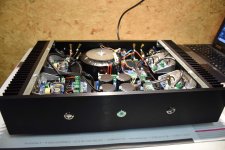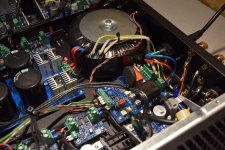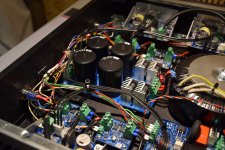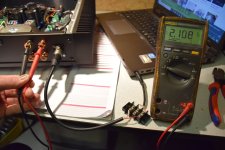Oy... That's not good. Connecting the metal tab of the LM3886T to the (grounded) heat sink blows the bond wire to pin 4 of the LM3886 rendering it dead. That is the one drawback of the metal tab version of the LM3886.
Thankfully the fix is usually easy: Replace the LM3886 ... but of course finding one these days is easier said than done.
Tom
Thankfully the fix is usually easy: Replace the LM3886 ... but of course finding one these days is easier said than done.
Tom
This amp will be done when it's done. Already spent too much to go back now. I have other projects to distract me until I have time to set it straight. I appreciate how helpful you've been.
Finally put the Modulus-86 on my Radian 475PB-8 compression driver in 12" round horn. Actively biamped, so no passive parts between the amp and driver.
This combo is so "ruthlessly revealing" that I had to change the DAC filter to slow rolloff and utilize some EQ to tame down around 2kHz.
If I could add some second harmonic distortion generator to add that "glow-from-within" distortion I get with my 2A3 and 300B SET, things would be perfect 🙂
This combo is so "ruthlessly revealing" that I had to change the DAC filter to slow rolloff and utilize some EQ to tame down around 2kHz.
If I could add some second harmonic distortion generator to add that "glow-from-within" distortion I get with my 2A3 and 300B SET, things would be perfect 🙂
Heh... Yeah. Some recordings do benefit from going through a fuzzbox. To my ears the absolute clarity I get on the good recordings is well worth the 'price' of the bad recordings sounding ... well ... bad. One could consider building a tube buffer preamp with a bypass switch. Add the even order harmonic distortion where it's desired and flip the bypass switch on the good recordings.
Tom
Tom
Tom,
I got the parts ordered for my last Mod86 channel. I am putting in 5 channels into 1 enclosure with a Power-686. I was going to go with a 400VA transformer. Just trying to pick between 22Vac or 25 Vac secondaries. I currently run JBL Studio 530s which are 6 ohm rated. So which one to go with for the most power. I am using 100mm of the modushop 2U heatsink for each channel.
I got the parts ordered for my last Mod86 channel. I am putting in 5 channels into 1 enclosure with a Power-686. I was going to go with a 400VA transformer. Just trying to pick between 22Vac or 25 Vac secondaries. I currently run JBL Studio 530s which are 6 ohm rated. So which one to go with for the most power. I am using 100mm of the modushop 2U heatsink for each channel.
±35-36 V is fine in an amp optimized for 6-8 Ω. The LM3886 starts running out of steam with a 4 Ω load at that supply voltage, which is why I recommend ±30 V for a general purpose 4-8 Ω compatible amp.
So a 2x25 VAC, 400 VA transformer with a Power-686 will be perfect for a 5-channel amp optimized for 6-8 Ω.
Tom
So a 2x25 VAC, 400 VA transformer with a Power-686 will be perfect for a 5-channel amp optimized for 6-8 Ω.
Tom
Well? You can't just leave us on a cliffhanger like that... how'd it go? 😆
First listening impressions were very promising. Still checking off my music reference list ( mostly classical music, opera, choir and brassband music).
Remarkable improvements are the lower bass ( <100 Hz) and upper-midrange (500-1000 Hz).
Definitely more grip on the bass. Straight and dry.
Upper midrange is more silky, with a natural clarity and a fine calmness. Very nice.
( Less upper harmonics and distortion ? )
As for the build :
Yes, it takes some metalwork skills and tools , a stable drill for the 16mm holes in the frontplate, and a good file and some patience for all connections on the back panel, but pleasure was mine.
Just followed the very well detailled documentation and the Neurochromes videos on YouTube.
Speaker pair selection ( A or B or A+B) is done with 2 DPST-switches ( latching ) on the Guardians input. No clicks or pops at all when powering up ( thanks Tom).
Final test results :
Toroidy Audio Grade 400VA – 2x 22V + Power 686 : +- 32V
DC-Offset (4 modules) : -2.7 / -2.4 / -0.3 / -2.7 mV
Gain ( 400 Hz ) : Input 105.1 mV → Output 2.1 V
Set-up : Laptop - Steinberg UR22mkII – Neurochrome 186 DS – Mezzo Galactica
Rik
Remarkable improvements are the lower bass ( <100 Hz) and upper-midrange (500-1000 Hz).
Definitely more grip on the bass. Straight and dry.
Upper midrange is more silky, with a natural clarity and a fine calmness. Very nice.
( Less upper harmonics and distortion ? )
As for the build :
Yes, it takes some metalwork skills and tools , a stable drill for the 16mm holes in the frontplate, and a good file and some patience for all connections on the back panel, but pleasure was mine.
Just followed the very well detailled documentation and the Neurochromes videos on YouTube.
Speaker pair selection ( A or B or A+B) is done with 2 DPST-switches ( latching ) on the Guardians input. No clicks or pops at all when powering up ( thanks Tom).
Final test results :
Toroidy Audio Grade 400VA – 2x 22V + Power 686 : +- 32V
DC-Offset (4 modules) : -2.7 / -2.4 / -0.3 / -2.7 mV
Gain ( 400 Hz ) : Input 105.1 mV → Output 2.1 V
Set-up : Laptop - Steinberg UR22mkII – Neurochrome 186 DS – Mezzo Galactica
Rik
Attachments
Tom, just ordered a stereo kit.
If I were to use the amp to power headphones (say the very inefficient Hifiman HE6), can I tie the (-) outputs from the two amps?
If I were to use the amp to power headphones (say the very inefficient Hifiman HE6), can I tie the (-) outputs from the two amps?
Good to hear. Thanks for sharing your impressions so far.First listening impressions were very promising.
The Speaker (-) output on the Modulus-86 is connected to ground so you can connect the Speaker (-) outputs from the two channels together.If I were to use the amp to power headphones (say the very inefficient Hifiman HE6), can I tie the (-) outputs from the two amps?
Thank you for your order. I appreciate it and your support of my business. I boxed up your order earlier. It'll be underway on Monday.
Tom
Tom, if I have to strategically deploy the rather expensive metal foil resistors (with 0.01% tolerance), I assume I should focus on R4,R7,R17 and R18? Any other places where they may make a subtle difference?
Will be using Caddock thick films for the Zobel and Thiele -- I think you mentioned somewhere thick films are good alternatives.
Will be using Caddock thick films for the Zobel and Thiele -- I think you mentioned somewhere thick films are good alternatives.
There's no need for fancy resistors (or fancy components in general) in the Modulus-86. That said, it's your project, your money, and your time and using fancy resistors won't degrade the performance, so if that's your desire I won't get in your way.
For Rev. 3.0 of the Modulus-86 these are the resistors I'd think would have the highest impact (most impact first):
You're probably wasting your money with fancy resistors in the Thiele and Zobel networks. Audio signals are prevented from going through the resistor by the capacitor (Zobel) and inductor (Thiele). Maybe your cats, dogs, and rats will appreciate the better ultrasonic performance of the amp. 🙂 That said, if you wish to geek out, go with a non-inductive resistor type. Metal film, metal foil, metal element. I think I would prefer a metal oxide resistor (what's specified on the BOM) over a thick film type, but don't have data to back that up. Thick film resistors often add distortion. I know this is true for low wattage resistors, but don't know if that translates to a physically large resistor.
Tom
For Rev. 3.0 of the Modulus-86 these are the resistors I'd think would have the highest impact (most impact first):
- R18
- R4, R7, R17
- If R14 is populated (i.e., gain > 20 dB) then R8, R14, R16
- R1, R2
You're probably wasting your money with fancy resistors in the Thiele and Zobel networks. Audio signals are prevented from going through the resistor by the capacitor (Zobel) and inductor (Thiele). Maybe your cats, dogs, and rats will appreciate the better ultrasonic performance of the amp. 🙂 That said, if you wish to geek out, go with a non-inductive resistor type. Metal film, metal foil, metal element. I think I would prefer a metal oxide resistor (what's specified on the BOM) over a thick film type, but don't have data to back that up. Thick film resistors often add distortion. I know this is true for low wattage resistors, but don't know if that translates to a physically large resistor.
Tom
Are C20 and C7 absolutely necessary if I can ensure that no DC is fed to the inputs of U2 LM4562?
Considering build a 6 channel modulus-86. I have some questions regarding power supplies. Can I run 2 Connex SMPS300RE or a single power 686?
I would not run more than two channels on a single SMPS300RE (or SMPS300REh). You could potentially entertain the thought of running six channels on an SMPS800RE, but I don't know if Connex can make them for ±30 V. I do know that they can make a ±36 V version of the SMPS800RE but that limits your amp to 8 Ω operation.
Six channels on a single Power-686 would be alright. Maybe a little light on capacitance compared to many DIY builds, but better than the vast majority of commercial amps. The Power-686 has 4x22000 uF. You might now be able to find a 27000 uF or 33000 uF that'll fit. The board accepts snap-in caps with 10 mm pin pitch and up to 40 mm in specified diameter (so actual max diameter is 41-42 mm).
Tom
Six channels on a single Power-686 would be alright. Maybe a little light on capacitance compared to many DIY builds, but better than the vast majority of commercial amps. The Power-686 has 4x22000 uF. You might now be able to find a 27000 uF or 33000 uF that'll fit. The board accepts snap-in caps with 10 mm pin pitch and up to 40 mm in specified diameter (so actual max diameter is 41-42 mm).
Tom
- Home
- Amplifiers
- Chip Amps
- Modulus-86 build thread




